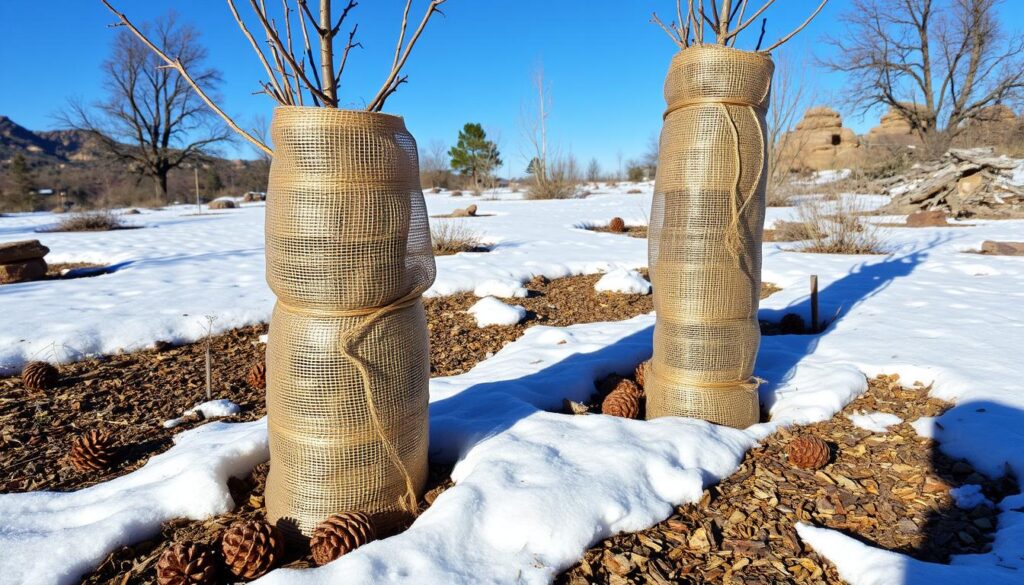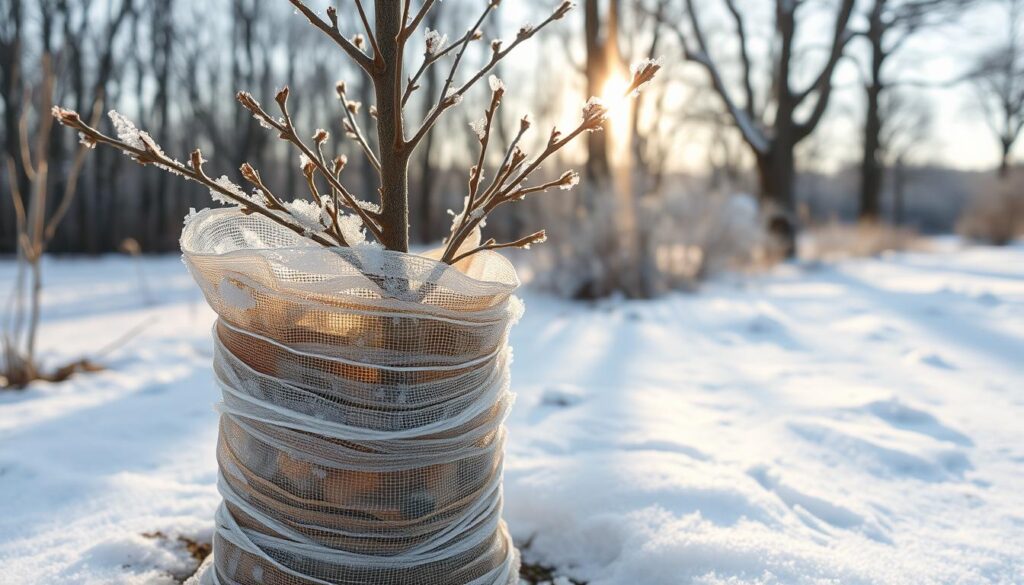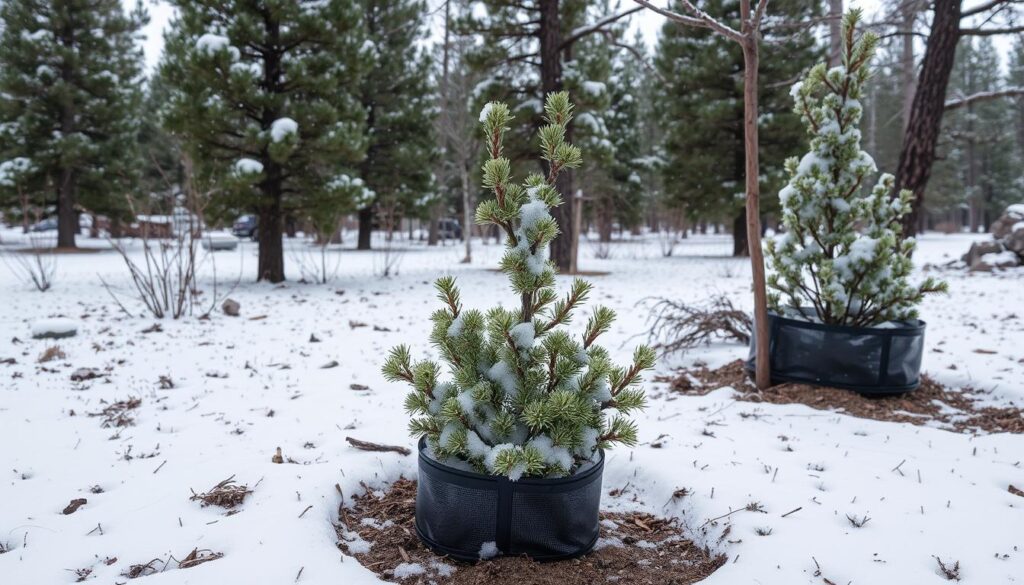
Winter tree care in Prescott, Arizona, is a big challenge for young saplings. The desert climate is harsh, making it key to protect saplings. Cold weather gardening is vital for their survival and growth during winter.
Prescott’s winter is tough on young trees, with big temperature swings and dry air. It’s important to care for and protect saplings well. This way, they can grow strong and healthy.
Knowing what saplings need in Prescott’s winter is crucial. Mulching, wrapping, and proper watering are key to protect them. These steps help your saplings make it through winter and bloom in spring.
Key Takeaways
- Sapling protection is crucial in Prescott’s high-altitude desert climate
- Winter tree care techniques help young trees survive cold months
- Proper mulching and wrapping provide essential insulation
- Adequate watering is important even during winter
- Cold weather gardening practices promote long-term tree health
Understanding Prescott’s Winter Climate Challenges for Young Trees
Prescott’s winter climate is tough for young trees. The city’s high-altitude desert setting makes growing trees a challenge. It requires extra care for saplings to grow well.
Typical Winter Temperature Fluctuations
Prescott’s winters see big temperature swings. Days can be in the 50s, but nights can drop below freezing. These quick changes can harm young trees.
High-Altitude Desert Climate Impact
Gardening at high altitudes in Prescott has its hurdles. The thin air and strong sun can dry out saplings. The dry winter air makes dehydration a bigger risk for young trees.
Common Winter Stress Factors
New trees face several challenges in Prescott’s winters:
- Frost damage to tender bark
- Desiccation from dry winds
- Snow and ice accumulation on branches
- Limited water availability due to frozen soil
Knowing these challenges is key to protecting young trees in winter. By tackling these issues, gardeners can help their saplings survive and grow during the cold months. Experience the greatness of this article.
Winter Tree Sapling Protection Methods
Keeping young trees safe in Prescott’s cold winters is key. We’ll look at ways to protect your saplings during this time.
Mulching for Winter Insulation
Mulching is a vital method for winter protection. Spread a 2-3 inch layer of organic mulch around your sapling. It keeps roots warm, holds moisture, and controls soil temperature. But, don’t pile mulch against the trunk to avoid rot.
Tree Wrap Application
Tree wrap protects young bark from sun damage and animals. Start wrapping from the bottom, going up and overlapping by one-third. Take off the wrap in spring to stop moisture and fungus issues.

Windbreak Installation
Windbreaks help reduce wind stress on saplings. Use burlap or snow fencing on the wind side of your trees. It helps keep moisture in and protects against winter damage.
Anti-desiccant Spray Benefits
Anti-desiccant sprays create a protective layer on leaves and needles. This waxy layer helps evergreens stay moist in dry winters. Spray on a dry day when it’s not freezing for the best effect.
Using these protection methods will help your saplings survive Prescott’s tough winters. Always check on your trees and adjust their care as needed. Give this impressive piece a read.
Watering and Soil Management During Cold Months
Winter watering is key for young trees in Prescott’s cold months. Even when it’s cold, saplings need water to live. Water deeply before the ground freezes to help roots stay healthy and prevent drought.
Good soil care helps trees get through harsh winters. Put a layer of mulch around the base to keep roots warm and moist. This helps prevent drought and keeps the soil warm.
Here are some winter watering tips:
- Water on warmer days when temperatures are above 40°F
- Focus on the tree’s drip line, not the trunk
- Use a slow trickle to allow water to soak deeply
Check soil moisture often. If the top 2-3 inches of soil feel dry, it’s time to water. Keeping the soil right helps roots stay healthy all winter. Healthy roots mean strong trees in the spring.
Physical Barriers and Support Systems
Protecting young trees in Prescott’s harsh winters is crucial. These methods keep them safe from wildlife and harsh weather. They help the trees grow strong and healthy.
Choosing the Right Tree Guards
Tree guards are the first defense for young trees. Pick ones that let air in but keep out rodents and deer. Plastic mesh guards are great for most saplings, growing with the tree.
Install them around the trunk, leaving space for the tree to grow. This ensures the guards fit as the tree gets bigger.

Effective Stake Support Techniques
Stakes help trees grow strong roots and straight trunks. Place two stakes on opposite sides of the tree, 18 inches from the trunk. Use flexible ties to hold the tree, allowing it to move a bit.
Remove the stakes after one to two growing seasons. This helps the tree grow on its own without being tied down.
Protective Fencing Options
Fencing protects groups of saplings or individual trees. Wire mesh fencing keeps out larger animals and can be removed when trees grow. For single trees, circular fencing around the drip line offers full protection.
Make sure the fencing is tall enough to stop deer from jumping over it.
- Choose sturdy materials resistant to Prescott’s winter conditions
- Install fencing before the first frost for maximum protection
- Check and maintain barriers regularly throughout the winter
Using these physical protection methods will help your young trees survive Prescott’s tough winters.
Seasonal Maintenance Schedule for Young Trees
A well-planned tree maintenance calendar is key for young trees in Prescott. Seasonal care helps your saplings grow all year. Let’s look at important tasks for each season.
Spring is when growth starts. Remove winter covers and check for damage. Prune dead branches and use slow-release fertilizer. Water deeply as the soil warms up to help new growth.
In summer, keep watering and mulch in check. Watch for pests and diseases, treating them fast. Don’t prune now to avoid stressing the tree.
Fall is great for planting new trees. For existing saplings, water less as it gets cooler. Add fresh mulch to protect roots. Remove dead or sick branches.
Winter pruning is vital. Prune during the tree’s rest to shape and remove bad branches. Use tree wraps or guards for protection. Water sometimes during dry spells to keep the tree hydrated.
- Monthly checks for pests and diseases
- Adjust watering based on rainfall and temperature
- Inspect and adjust support systems as needed
Following this care schedule ensures your young trees stay strong and healthy all year.
Identifying and Addressing Winter Damage in Saplings
Winter can be hard on young trees. It’s important to know how to spot and treat frost damage, sunscald, and winter burn. This helps your saplings grow strong.
Frost damage often shows as blackened or brown leaves and twigs. You might see cracked bark or split branches. Sunscald has sunken, discolored areas on the trunk, usually on the south or southwest side. Winter burn makes evergreens’ needles brown or bleached.
To help your tree recover, follow these steps:
- Wait until spring to see how bad the damage is
- Prune dead or damaged branches, making clean cuts
- Water deeply when the soil thaws to help roots recover
- Apply a balanced fertilizer to support new growth
- Protect the tree from further stress with mulch and proper care
Remember, patience is key. Some trees may look dead but can recover with the right care. If you’re unsure about the damage or how to help, ask a local arborist for advice.
Long-term Benefits of Proper Winter Tree Care
Caring for young trees in Prescott’s harsh winters is a smart move. The right protection helps saplings grow into strong, healthy trees. These trees can last for decades, thanks to good winter care.
When spring comes, trees that made it through winter grow better. They develop strong roots and branches. This makes them ready for future challenges.
Winter-protected trees also become more resistant to diseases. They’re less likely to get sick or attacked by pests. This means they stay healthy for a long time.
Well-cared-for trees add a lot of value to your landscape. As they grow, they provide shade, privacy, and a home for wildlife. They become landmarks in your yard, making your home look and feel better for years.
Yavapai Landscaping Prescott offers free estimates for Prescott and nearby locations for landscaping & tree services, which include tree elimination, tree pruning, stump grinding, land clearing, storm clean-up, and emergency tree care.
